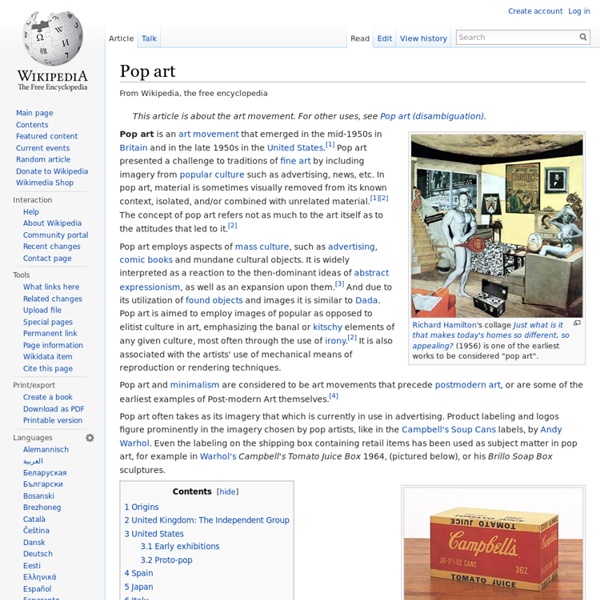Andy Warhol
Andy Warhol (/ˈwɔrhɒl/;[1] August 6, 1928 – February 22, 1987) was an American artist who was a leading figure in the visual art movement known as pop art. His works explore the relationship between artistic expression, celebrity culture and advertisement that flourished by the 1960s. After a successful career as a commercial illustrator, Warhol became a renowned and sometimes controversial artist. The Andy Warhol Museum in his native city, Pittsburgh, Pennsylvania, holds an extensive permanent collection of art and archives. It is the largest museum in the United States dedicated to a single artist. Warhol's art encompassed many forms of media, including hand drawing, painting, printmaking, photography, silk screening, sculpture, film, and music. Early life (1928–1949) In third grade, Warhol had Sydenham's chorea (also known as St. As a teenager, Warhol graduated from Schenley High School in 1945. 1950s 1960s Campbell's Soup I (1968) Attempted murder (1968) 1970s 1980s
Roy Lichtenstein
Roy Fox Lichtenstein (pronounced /ˈlɪktənˌstaɪn/; October 27, 1923 – September 29, 1997) was an American pop artist. During the 1960s, along with Andy Warhol, Jasper Johns, and James Rosenquist among others, he became a leading figure in the new art movement. His work defined the basic premise of pop art through parody.[2] Favoring the comic strip as his main inspiration, Lichtenstein produced hard-edged, precise compositions that documented while it parodied often in a tongue-in-cheek humorous manner. His work was heavily influenced by both popular advertising and the comic book style. He described pop art as "not 'American' painting but actually industrial painting".[3] His paintings were exhibited at the Leo Castelli Gallery in New York City. Whaam! Early years[edit] Career[edit] Cap de Barcelona, sculpture, mixed media, Barcelona Lichtenstein entered the graduate program at Ohio State and was hired as an art instructor, a post he held on and off for the next ten years. Later work[edit]
Jasper Johns
Detail of Flag (1954-55). Museum of Modern Art, New York City. This image illustrates Johns' early technique of painting with thick, dripping encaustic over a collage made from found materials such as newspaper. Jasper Johns, Jr. Life[edit] Born in Augusta, Georgia, Jasper Johns spent his early life in Allendale, South Carolina, with his paternal grandparents after his parents' marriage failed. Johns studied a total of three semesters at the University of South Carolina, from 1947 to 1948.[2] He then moved to New York City and studied briefly at the Parsons School of Design in 1949.[2] In 1952 and 1953 he was stationed in Sendai, Japan during the Korean War.[2] In 1954, after returning to New York, Johns met Robert Rauschenberg and they became long-term lovers. Johns currently lives in Sharon, Connecticut and on the Island of Saint Martin.[9] Until 2012, he lived in a rustic 1930s farmhouse with a glass-walled studio in Stony Point, New York. Work[edit] Painting[edit] Sculpture[edit] Notes
Neo-Dada
Neo-Dada is a minor audio and visual art movement that has similarities in method or intent to earlier Dada artwork. While it revived some of the objectives of dada, it put "emphasis on the importance of the work of art produced rather than on the concept generating the work".[1] It is the foundation of Fluxus, Pop Art and Nouveau réalisme.[2] Neo-Dada is exemplified by its use of modern materials, popular imagery, and absurdist contrast. It also patently denies traditional concepts of aesthetics. The term was popularized by Barbara Rose in the 1960s and refers primarily, although not exclusively, to a group of artwork created in that and the preceding decade. See also[edit] Anti-art [edit] Jump up ^ "neo-dada". References[edit] Susan Hapgood, Neo-Dada: Redefining Art, 1958-62.
Stuart Davis
Stuart Davis (December 7, 1892 – June 24, 1964), was an early American modernist painter. He was well known for his jazz-influenced, proto pop art paintings of the 1940s and 1950s, bold, brash, and colorful, as well as his ashcan pictures in the early years of the 20th century. He was born in Philadelphia to Edward Wyatt Davis and Helen Stuart Davis. In 1913, Davis was one of the youngest painters to exhibit in the controversial Armory Show, where he displayed five watercolors.[3] Exposed at this exhibition to the work of such artists as Vincent van Gogh, Henri Matisse, and Pablo Picasso, Davis became a committed "modern" artist and a major exponent of cubism and modernism in America.[3] He spent summers painting in Gloucester, Massachusetts, and made painting trips to Havana in 1918 and New Mexico in 1923.[3] In 1928, he visited Paris, where he painted street scenes. He was represented by Edith Gregor Halpert at the Downtown Gallery in New York City. Tree and Urn, 1921, 30 x 19 inches



